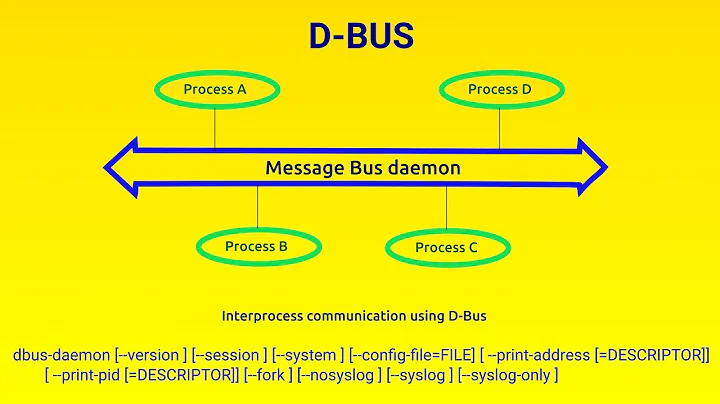Find out the owner of a DBus service name
Solution 1
The d-bus debug utility d-feet which is available as a package in many systems seems to be able to find the process id and command providing a service. For example, I ran it on a Fedora 23 xfce4 X11 systemd platform and selected Session Bus and entered the service name org.freedesktop.Notifications. It introspected the service, activating it, and showed the pid and /usr/lib64/xfce4/notifyd/xfce4-notifyd command:
Solution 2
You can get the caller PID via org.freedesktop.DBus.GetConnectionUnixProcessID:
gdbus call --session --dest org.freedesktop.DBus --object-path / --method \
org.freedesktop.DBus.GetConnectionUnixProcessID org.freedesktop.Notifications
prints
(uint32 737,)
so there's your PID. If you prefer dbus-send (as gdbus is GNOME specific) then:
dbus-send --session --print-reply --dest=org.freedesktop.DBus / \
org.freedesktop.DBus.GetConnectionUnixProcessID string:org.freedesktop.Notifications
Related videos on Youtube
Gonzalo Pincheira Arancibia
Updated on September 18, 2022Comments
-
 Gonzalo Pincheira Arancibia over 1 year
Gonzalo Pincheira Arancibia over 1 yearI'm new using Restangular and I don't understand how resolve the promises using my own service. I' ve been trying to return the
customGETmethod but in my controller the response it's a object that contain all the methods of the restangular resource, so i don't understand how get the response data. I inspect the network activity and the data it's retrieved.My Service
angular .module('Form29') .service('Form29Service', Service); Service.$inject = ['Restangular']; function Service(Restangular) { this.serviceResource = Restangular.all('forms'); this.getForm29 = getForm29; function getForm29(_month, _year, _type) { var params = { rut: '76195496', month: _month, year: _year, type: _type }; return this.serviceResource.customGET('',params); } }My Controller
angular .module('Form29') .controller('Form29Controller', Controller); Controller.$inject = ['Form29Service']; function Controller(Form29Service) { var vm = this; vm.submitForm = submitForm; function submitForm(month, year, type){ Form29Service.getForm29(month, year, type).then(showForm); } function showForm(response){ console.log(response); } }-
Silvinus almost 8 yearsDid you try to replace return this.serviceResource.customGET('',params); by this.serviceResource.get(params)
-
Austin Hemmelgarn almost 7 yearsI don't know of a way to get this information generically, but in this case the particular service you're asking about is usually provided by a daemon bundled with your desktop environment (Cinnamon, XFCE4, and MATE all do it this way), and it's usually somewhat difficult to get the desktop to use a different notification daemon if it comes with one bundled.
-
Mael almost 7 years@AustinHemmelgarn Thanks. I'm running AwesomeWM which does not bundle notifications daemon (I'm not actually sure about it, I'll investigate, thanks for the clue).
-
Austin Hemmelgarn almost 7 yearsI think AwesomeWM provides the service itself internally actually (at least, on Gentoo and Debian it appears to be recognized as a notification provider). If not, the most likely possibility is 'notify-osd', as that's the most widely used desktop-agnostic notification daemon out there.
-
Mael almost 7 years@AustinHemmelgarn You've pointed me in the right direction! It was enough to comment out require("naughty") in Awesome's config, restart, and I was able to launch the daemon I wanted.
-
Austin Hemmelgarn almost 7 yearsFor what it's worth, I'm actually still kind of curious myself if somebody out there knows of a way to trace a service name in DBus back to a process. I bet there is something to do so, but a cursory look at the documentation isn't revealing anything for me either.
-
 meuh almost 7 years@AustinHemmelgarn I dont know how it does it, but
meuh almost 7 years@AustinHemmelgarn I dont know how it does it, butd-feetfound a pid. See my answer.
-






